| Toyota Belta | |
|---|---|
 Toyota Yaris sedan (NCP93L; pre-facelift, US) Toyota Yaris sedan (NCP93L; pre-facelift, US) | |
| Overview | |
| Manufacturer | Toyota |
| Model code | XP90 |
| Also called |
|
| Production |
|
| Model years | 2006–2016 |
| Assembly |
|
| Designer |
|
| Body and chassis | |
| Class | Subcompact car |
| Body style | 4-door sedan |
| Layout | |
| Platform | Toyota B platform |
| Related | |
| Powertrain | |
| Engine | |
| Transmission | |
| Dimensions | |
| Wheelbase | 2,550 mm (100.4 in) |
| Length | 4,300 mm (169.3 in) |
| Width | 1,690–1,700 mm (66.5–66.9 in) |
| Height | 1,460–1,480 mm (57.5–58.3 in) |
| Kerb weight | 990–1,120 kg (2,183–2,469 lb) |
| Chronology | |
| Predecessor |
|
| Successor |
|
The Toyota Belta (Japanese: トヨタ・ベルタ, Hepburn: Toyota Beruta), marketed as the Vios in selected Asian markets and elsewhere as the Yaris sedan, is a subcompact sedan manufactured by Toyota.
The successor to the Platz, the Belta has increased in size over the previous generation such that its interior volume is comparable to the E120 series Corolla. The Belta went on sale in Japan on 28 November 2005 equipped with 1.0 to 1.3 L engines and was available at Toyopet Store dealerships. Export sales began in early 2006, with most markets receiving a 1.5 L 1NZ-FE engine as standard fitment. The smaller 1.3 L 2NZ-FE engine was also offered for selected markets. The sedan was introduced as second generation Vios for Southeast Asian market in April 2007, succeeding the XP40 series Vios.
In June 2012, the Japanese market Belta was discontinued and replaced by the E160 series Corolla Axio, and it was dropped in the North America to be replaced by the Mazda2 sedan-based Scion iA/Yaris sedan in July 2015. However, the Belta was still produced in Japan for export to Australia until it was discontinued in June 2016. For the Asian market, the XP150 series Vios replaced the XP90 model in March 2013 as the sedan counterpart to the XP150 series Yaris hatchback.
The "Belta" nameplate was revived in November 2021 for the rebadged Suzuki Ciaz sold in Africa.
The name "Belta" is a contraction of the Italian words "bella gente", or "beautiful people".
Development
The XP90 series Vitz and Belta share underpinnings with each other including the drivetrain and platform. However, while the Vitz was designed at Toyota's French design studio (Toyota ED²), the Belta was designed at Toyota's Japanese design studio (TMC Design Division) — design projects for similar cars marketed toward different demographics. While the outgoing XP10 series Vitz and Platz models look and feel very much alike, the newer Vitz hatchback and Belta sedan are more subtly related. No sheetmetal is shared between the two, and although both have a similar centralized dashboard design (Toyota's efforts to standardize the design for all markets, left or right hand drive at the time) there are some cosmetic differences. It has a drag coefficient of Cd=0.29, marginally more aerodynamic than its hatchback counterpart.
For the Japanese and rest of the world, the Belta/Yaris sedan were manufactured in Japan. While the Vios was manufactured in China and Southeast Asia.
Markets
Asia
For most Asian markets (except Japan), the Belta was sold as the second generation Vios which was built and assembled in China, Malaysia, the Philippines, Thailand and Vietnam. The Belta was also sold in Middle East as the Yaris sedan.
As was the first generation Vios, the second generation Vios was continued to assembled at Thailand's Toyota Gateway Plant, and also by FAW Toyota in China.
The second generation Vios was the best-selling car in Southeast Asia in 2009. For the 2010 facelift model, the Vios received more luxurious makeover than the facelifted Belta/Yaris sedan.
Japan
Debuted in November 2005, the Japanese market Belta had three engine variants available, namely the 71 PS (52 kW; 70 hp) 1.0 L 1KR-FE straight-three engine (KSP92) and two variants of the 1.3 L inline-four engines, 2NZ-FE (NCP96) or 2SZ-FE (SCP92), both rated at 87 PS (64 kW; 86 hp). The 1KR-FE and 2SZ-FE engines comes with Super CVT-i transmission and not available elsewhere, while the 2NZ-FE engine has a 4-speed Super ECT transmission and only available with AWD system as standard. The sedan was offered with two trim levels; X (available with sporty "S Package" option) and G. The 1.0 L engine in not available for the G trim and the AWD system is available for both trims with the 1.3 L 2NZ-FE engine. In October 2006, the cheaper model called "Business Package" was introduced, aimed for the company fleet market. It is basically X trim with less equipments.
The Belta received a facelift in August 2008, the exterior was updated with new honeycomb grille, new mirror wings with blinker and redesign hubcaps. For the interior, the instrument cluster and seat upholstery were redesigned, the driver's seat was also equipped with heater for the G trim. The sporty "S Package" was also abolished (although it was still available as dealer optional accessories for every trim) and being replaced by luxury "L Package" (added some equipment from G trim such as driver's heated seat, automatic AC etc.). The sedan was discontinued for the Japanese market in 2012 and succeeded by the Corolla Axio, although it was still produced for the export market until 2016.
-
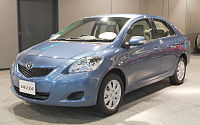 2008 Toyota Belta 1.3 X "L Package" (SCP92; facelift, Japan)
2008 Toyota Belta 1.3 X "L Package" (SCP92; facelift, Japan)
-
 2008 Toyota Belta 1.3 X "L Package" (SCP92; facelift, Japan)
2008 Toyota Belta 1.3 X "L Package" (SCP92; facelift, Japan)
-
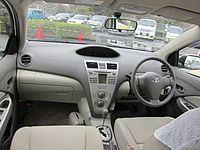 Toyota Belta X "L Package" interior
Toyota Belta X "L Package" interior
China
The second generation Vios was introduced to China in 2008. Engine choices for Chinese variants consist of the 1.3-litre 2NZ-FE and the 1.6-litre 4ZR-FE only available in China. 5-speed manual and 4-speed automatic are available as standard. Sunroof option is also available exclusively for this market.
Mainland China Vios trim levels include:
- 1.3/1.6 GL-i
- 1.6 GL-S
- 1.6 GLX-i
-
 Toyota Vios 1.6 GL-i (ZSP92; pre-facelift, China)
Toyota Vios 1.6 GL-i (ZSP92; pre-facelift, China)
-
 Toyota Vios 1.6 GL-i (ZSP92; pre-facelift, China)
Toyota Vios 1.6 GL-i (ZSP92; pre-facelift, China)
-
 Toyota Vios (facelift, China)
Toyota Vios (facelift, China)
Lifan made a copy of Vios with different front and rear fascia and marketed as the 530. It was also rebadged and sold in Ghana as Kantanka Amoanimaa.
Southeast Asia
Indonesia
The second generation Vios (and Limo) was officially launched to the Indonesian market in April 2007, imported from Thailand. The sedan was marketed with backronym "Very Intelligent, Outstanding Sedan!". Like the outgoing NCP42, the NCP93 Vios was offered in Limo (exclusively for taxi fleet), E and G trim levels and powered by the same 1.5-liter 1NZ-FE engine. The Indonesian market Vios (excluding Limo) can be distinguished from other markets Vios with its V-shaped grille ornament.
The E and G trims come equipped with ABS plus EBD and BA (2007 model only for Limo), driver's side airbag, 2-DIN audio system, power window, window and power door lock and wing mirrors with electric adjuster and retract as standard. The highest grade G trim received more safety and convenience features such as passenger's side airbag, immobilizer, rear disc brake, rear parking sensor and keyless entry for the automatic transmission model. For the interior, both the Limo and E trims has full black interior color and additional power windows, power door and windows lock, fabric seat upholstery and door trim as standard for the latter. Meanwhile, the G trim has two tone black and beige colors combination plus additional leather wrapped steering wheel, audio control on the steering wheel, start/stop button for automatic transmission model, blue-colored optitron instrument cluster with multi-information display and 60:40 split back seat. For the exterior, the Limo can be distinguished by the use of 14-inch steel wheels, blinkers on the front fender, the lack of third stop light and unpainted door handles and trunk ornament. The middle E trim received V-shaped ornament on the front grille, side body moulding, blinkers on wing mirrors, body colored trunk ornament and 14-inch alloy wheels. The top of the line G trim added the front and rear fog lamps, auto-leveling HID headlamps, 15-inch alloy wheels, keyless entry button for the automatic transmission model and chrome ornament on the trunk.
The facelifted model was introduced in April 2010 and followed the same exterior appearance as the Southeast Asian and Chinese market. The interior is also slightly changed with additional automatic door lock and new flat-bottom style steering wheel as standard, while the G trim received additional chrome gate shift and back seat with armrest with cup holder. The E trim is also received rear parking sensors. In addition to the regular trim levels, there was also a TRD Sportivo model based on the G trim which adds an all-round body kit to the exterior and comes fitted with an AV DVD player and navigational capabilities. Meanwhile, the Limo did not receive any improvement.
According to Association of Indonesian Automotive Industries (GAIKINDO), roughly 63.000 units (62% for Limo and 38% for Vios) were sold in the country.
-
 Pre-facelift Indonesian-spec Toyota Vios G (NCP93R) with "V" grille
Pre-facelift Indonesian-spec Toyota Vios G (NCP93R) with "V" grille
-
 Toyota Vios E (NCP93R; pre-facelift, Indonesia)
Toyota Vios E (NCP93R; pre-facelift, Indonesia)
-
 Toyota Limo (NCP93R; Indonesia)
Toyota Limo (NCP93R; Indonesia)
-
 Toyota Limo (NCP93R; Indonesia)
Toyota Limo (NCP93R; Indonesia)
-
 Toyota Vios G interior (facelift)
Toyota Vios G interior (facelift)
Malaysia
The second generation Vios was unveiled in Kuala Lumpur, Malaysia on 5 October 2007, two weeks ahead of its official launch on 19 October 2007. The Vios is powered exclusively by the same 1NZ-FE 1.5 L four-cylinder engine with VVT-i used in the old Vios, but included a redesigned air intake and exhaust system to improve low to mid-range torque. It was also fitted with the Super ECT four-speed automatic with the same gear ratios as its predecessor, but with improved programming for the transmission control unit. Electric power steering was offered in place of the hydraulic system in its predecessor. The second generation Vios was made available in four trim levels for the Malaysian market: J, E, G and S.
The J is the base version. It was initially unavailable at the Malaysian Vios launch in October 2007, but was introduced on 1 July 2008, offering a choice of either 5-speed manual or 4-speed automatic transmissions.
The E and G differ mostly in terms of equipment levels and are mechanically identical, both sharing the 4-speed Super ECT transmission.
The S is an addition featuring cosmetic enhancements, including a front bumper spoiler, side skirts, rear skirt and a bootlid spoiler. The interior received a dark grey/black trim treatment and an Optitron meter with a multi-information display, as opposed to the E and G trims' conventional backlit display. The S trim was the most expensive Vios variant. On 17 June 2009, UMW Toyota launched the Vios 1.5 TRD Sportivo which effectively replaced the S trim. It featured a body kit, Enkei wheels, various interior trim improvements and an optional sports suspension kit.
On 15 April 2010, the Vios received a facelift in Malaysia, offering mostly cosmetic improvements. The Vios TRD Sportivo was updated on 29 June 2011, featuring a redesigned grille, unique alloy wheels and leather seats. Another new grade positioned between G and TRD Sportivo called the G Limited was also introduced offering a body kit, 15-inch alloy wheels and leather seats. The Vios was updated on 21 June 2012 in response to Honda Malaysia's facelift of the fifth generation City, with appearance changes without significant mechanical improvements.
All model grades included ABS with EBD and BA at the October 2007 launch, but the E trim was only offered with a single driver's airbag, whereas the G and S trims had an additional passenger airbag. The J trim had no airbags at all upon its July 2008 launch, but was nonetheless offered with ABS + EBD and BA. The J trim later received a driver's airbag in its 2010 facelift and a front passenger airbag in its 2012 update.
The Malaysian Vios was assembled locally by ASSB, a subsidiary of UMW Toyota, in Shah Alam, Selangor. The Vios has since become the best selling non-national badged vehicle in Malaysia, achieving record sales in 2012.
-
 2008–2010 Toyota Vios 1.5 J (NCP93R; pre-facelift, Malaysia)
2008–2010 Toyota Vios 1.5 J (NCP93R; pre-facelift, Malaysia)
-
 Toyota Vios 1.5 S (NCP93R; pre-facelift, Malaysia)
Toyota Vios 1.5 S (NCP93R; pre-facelift, Malaysia)
-
 Toyota Vios 1.5 S (NCP93R; pre-facelift, Malaysia)
Toyota Vios 1.5 S (NCP93R; pre-facelift, Malaysia)
-
 2010 Toyota Vios 1.5 G with TRD Sportivo body kits (NCP93R; pre-facelift, Malaysia)
2010 Toyota Vios 1.5 G with TRD Sportivo body kits (NCP93R; pre-facelift, Malaysia)
-
 2010 Toyota Vios 1.5 G with TRD Sportivo body kits (NCP93R; pre-facelift, Malaysia)
2010 Toyota Vios 1.5 G with TRD Sportivo body kits (NCP93R; pre-facelift, Malaysia)
-
 2011 Toyota Vios 1.5 J (NCP93R; facelift, Malaysia)
2011 Toyota Vios 1.5 J (NCP93R; facelift, Malaysia)
-
 2011 Toyota Vios 1.5 J (NCP93R; facelift, Malaysia)
2011 Toyota Vios 1.5 J (NCP93R; facelift, Malaysia)
Philippines
In the Philippines, the second generation Vios was launched in August 2007 in 3 trim levels: 1.3 J, 1.3 E and 1.5 G. All trim levels were available with a 5-speed manual transmission, the G trim also with a 4-speed automatic transmission.
The 1.5 G XX Limited was released in July 2008. This is the same as the G trim, but came with HID headlights, 17-inch 10-spoke alloy wheels and a small rubber spoiler. The 1.5 S also got this spoiler and different 17-inch Rota Bolognia Mags with 205/45 tires. The G XX Limited and S trims were released in different colour schemes.
A facelifted model was launched on April 6, 2010, with a redesigned front grille, redesigned headlamp and tail lamp assemblies, and redesigned 15-inch alloy wheels (for the G trim). It was available in three trim levels: the base 1.3 J mated to a 5-speed manual transmission, the 1.3 E, with the choice of a 5-speed manual or the now available 4-speed automatic transmission, and the 1.5 G, with the choice of a 5-speed manual or 4-speed automatic transmission.
For 2012, a 1.3-liter engine for the G trim was released, and it was mated to a 4-speed automatic transmission, then later a 5-speed manual transmission equipped with fog lights and 15-inch alloy wheels. Three new trims were also available from 2012, a trim higher than G trim called the 1.5 G SE Limited, a trim between the J and E trims called the 1.3 J Limited which added fog lights, 15-inch alloy wheels, front passenger airbag and more colors option from the E trim, and a trim lower than the J trim called the 1.3 Base, which came only in a 5-speed manual transmission. In 2013, the 1.5 TRD Sportivo trim was released.
During its entire period on the market, the second generation Vios was the best selling car in the Philippines helping Toyota to maintain its status as the best selling brand in the country.
-
 2008 Toyota Vios 1.5 G XX Edition (NCP93L; pre-facelift, Philippines)
2008 Toyota Vios 1.5 G XX Edition (NCP93L; pre-facelift, Philippines)
-
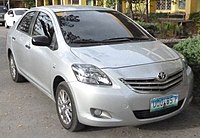 2013 Toyota Vios 1.3 J (NCP92L; facelift, Philippines)
2013 Toyota Vios 1.3 J (NCP92L; facelift, Philippines)
-
 2012 Toyota Vios 1.5 G SE Limited (NCP93L; facelift, Philippines)
2012 Toyota Vios 1.5 G SE Limited (NCP93L; facelift, Philippines)
-
 2012 Toyota Vios 1.5 G SE Limited (NCP93L; facelift, Philippines)
2012 Toyota Vios 1.5 G SE Limited (NCP93L; facelift, Philippines)
Singapore
In Singapore, the Vios was sold in the base model J, the mid-level E and the top-of-the-line G trim levels, and later the TRD Sportivo model.
The J trim is the lowest version and comes standard with a CD/MP3/WMA player with 4 speakers, keyless entry, ABS/EBD/BA (on front disc brakes only), driver-only SRS airbag and interior fabric with dark grey colour seats.
The E trim is the only manual variant after the local dealer discontinued the manual J variant in Singapore. The E Classic includes an additional SRS airbag for the front passenger and side moulding. There is another variant of the E trim known as the Elegance that includes leather seats and fog lights.
The G trim is the top-of-the-line version available in Singapore and comes with an automatic transmission. The G trim adds optitron meters with multi-information display, four-wheel disc brakes, and 60:40 split foldable rear seats.
Optional "Sport" and “Racing” bodykit were offered in late 2008 featuring aftermarket alloy wheels, red stitching on the leather seats and floor mats, gear knob, brushed studded pedals and badging to denote these models in its special run. These were available as optional extras by the Toyota dealership in Singapore (Borneo Motors). With the facelift in 2011, three colours were added – Grey Metallic (1G3), Attitude Black Mica (211) and Blackish Red Mica (3R0) – to make 7 colours in total. In December 2012, Borneo Motors (Singapore) introduced a "Sportivo" variant based on the E grade, consisting of a TRD sports kit and 15” TRD multi-spoke alloy rims. Trims were also split into LX Classic and LX Elegance for the J and E variants. These were offered as a cost effective measure for customers who wanted the variant in base form or with extras such as leather seats, piano black interior trims and solar film. In 2013, only the E grade remained in the lineup for the Vios.

Thailand

Thailand, which currently manufactures the Vios, was offered in three trim levels (J, E and G), as well as two limited edition trim levels (G Limited and S Limited). Thailand was currently the only country that offers all existing grades of the Vios, while export markets are only given a fraction of the Thai range in varying combinations. In addition, certainly the range of equipment in Thai Vios' differs from those in export versions.
The J is the basic trim level of the second generation Vios, offering a CD/MP3/WMA player with four speakers, an optional keyless entry with TVSS, ABS/EBD/BA, 15-inch steel wheels with hubcaps, rear fog lamps and interior fabric with dark grey colour seat.
The E is a mid-level trim featuring a keyless entry with TDS, an option between dark grey or ivory-coloured seat fabrics, optional driver and front passenger SRS airbags, front and rear fog lamps, 15-inch sports alloy wheels and side moulding.
The G trim features an unchangeable 6 speaker CD/MP3/WMA player, leather seating in either dark grey or ivory, driver and front passenger SRS airbags, a multi-functional steering wheel, 15-inch sports alloy wheels front and rear fog lamps, side moulding, a blue "Optitron" panel with a multi-information display and 60:40 fold-down rear seats.
The G Limited trim includes a keyless and smart entry with TDS, a Start/Stop push button, an immobilizer key and a body kit to the exterior.
The limited edition S Limited trim features a "Wrap-Around Aeropart" body kit, an orange "Optitron" panel with a multi-information display, high intensity discharge headlamps with automatic height adjustment and all-wheel disc brakes.
Audio systems in all second generation Vios trim levels are equipped with ASL (Auto-Speed Sound Levelizer), which detects and compensates for changes in external noise levels, adjusting volume and tone controls automatically based on the car's speed.
Toyota Thailand has also exported the Vios to the Middle East, Australia and South Africa, where it was sold as the Yaris.
The second generation Vios has been campaigned in One Make Races in Bangkok.
North America
The Belta went on sale in North America in March 2006 for the 2007 model year, being badged as the Yaris sedan, since these markets use the Yaris nameplate for the 3-door (last model year of availability there was 2008) and 5-door Vitz hatchbacks, also known as the Yaris 3-door and Yaris 5-door "liftback", respectively.
In the United States, the Yaris sedan is available with modular convenience, power, and all-weather guard packages, contrasting with the global Belta's conventional trim levels. However, the Yaris sedan was also available as the Yaris S, which has standard convenience and appearance packages fitted as standard. The power package on the Yaris sedan offers alloy wheels as an option. Side airbags were optional. The Canadian version is being based on the US-market Yaris S with power and all-weather guard packages, but with standard 14-inch (360 mm) wheels. The regular CE, LE and RS trims used in the Canadian Yaris hatchback are replaced in the Yaris sedan by option packages of B, C, D or Aero types. The B adds 15-inch (380 mm) all-season tires, chrome trim on the decklid, front and rear splash guards, colour-keyed door handles, blacked-out side window frames, keyless entry and power door locks; the C adds ABS, air conditioning, power windows, colour-keyed mirrors and power mirrors; the D adds both side and side-curtain airbags; the Aero adds alloy wheels, wheel locks, a rear spoiler and a body kit. The Aero, however, has neither air conditioning nor side airbags. The Canadian model lacks the two-tone interior, pseudo-metallic trim on the door panels and the new audio system controls (instead it uses an old design) found on the Japanese and American models.
The 2007 Yaris sedan received EPA fuel economy ratings of 40 mpg‑US (17.0 km/L) on the highway and 34 mpg‑US (14.5 km/L) in the city, with a fuel capacity of 42 L (11.1 US gal). However, because the EPA changed the way they calculate fuel economy, ratings were revised for the 2008 model year and the Yaris was rated at 29 mpg‑US (12.3 km/L) city/36 mpg‑US (15.3 km/L) mpg highway for the manual transmission, and 29 mpg‑US (12.3 km/L) mpg city/35 mpg‑US (14.9 km/L) mpg highway for the automatic version.
For the 2009 model year which was a facelift, all Yaris sedans received updated styling with a new grille, alloy designs, interior fabric, standard side curtain airbags and anti-lock brakes. There are also options such as a leather-wrapped steering wheel/shift knob and satellite radio.
While the hatchback was replaced by the XP130 series Yaris in 2011, the sedan was continued to be on sale until it was replaced by Mazda2-based Scion iA/Yaris sedan in summer 2015.
-
 Toyota Yaris (NCP93L; pre-facelift, US)
Toyota Yaris (NCP93L; pre-facelift, US)
-
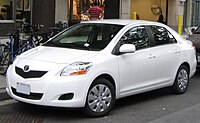 Toyota Yaris (NCP93L; facelift, US)
Toyota Yaris (NCP93L; facelift, US)
-
Yaris sedan rear view (Canada)
Australia
In Australia, it is known as the Yaris sedan and was sold alongside the Vitz-based Yaris hatchback. The Yaris sedan was available only in a 1.5 L 1NZ-FE 81-kilowatt (109 hp) petrol engine. There were two variants of the model, namely the YRS and YRX, with the former being the model with the basic necessities. The YRX model features an all-round body kit and was available in an automatic transmission or 5-speed manual transmission.
The Australian version of the Yaris sedan uses orange blinker bulbs with clear lenses instead of orange blinker lenses.
At the end of 2016, the Australian version Yaris sedan was discontinued due to poor sales with over 27 percent drop. It was then phased out with no direct replacement for the Australian market.
-
 2007 Toyota Yaris YRS (NCP93R; pre-facelift, Australia)
2007 Toyota Yaris YRS (NCP93R; pre-facelift, Australia)
-
 2007 Toyota Yaris YRS (NCP93R; pre-facelift, Australia)
2007 Toyota Yaris YRS (NCP93R; pre-facelift, Australia)
-
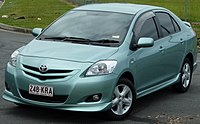 2009 Toyota Yaris YRX (NCP93R; pre-facelift, Australia)
2009 Toyota Yaris YRX (NCP93R; pre-facelift, Australia)
-
 2009 Toyota Yaris YRX (NCP93R; pre-facelift, Australia)
2009 Toyota Yaris YRX (NCP93R; pre-facelift, Australia)
-
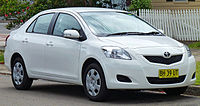 2008–2010 Toyota Yaris YRS (NCP93R; facelift, Australia)
2008–2010 Toyota Yaris YRS (NCP93R; facelift, Australia)
-
 Interior
Interior
Powertrain
| Code | Engine | Power | Torque | Transmission | Market |
|---|---|---|---|---|---|
| KSP92 | 997 cc (1.0 L) 1KR-FE I3 |
71 PS (52 kW; 70 hp) at 6,000 rpm | 94 N⋅m (69 lb⋅ft; 10 kg⋅m) at 3,600 rpm | K410 CVT | Japan |
| SCP92 | 1,298 cc (1.3 L) 2SZ-FE I4 |
87 PS (64 kW; 86 hp) at 6,000 rpm | 116 N⋅m (86 lb⋅ft; 12 kg⋅m) at 4,000 rpm | ||
| NCP92 NCP96 (all-wheel drive) |
1,298 cc (1.3 L) 2NZ-FE I4 |
86 PS (63 kW; 85 hp) at 6,000 rpm 87 PS (64 kW; 86 hp) at 6,000 rpm (Japan) |
120 N⋅m (89 lb⋅ft; 12 kg⋅m) at 4,400 rpm (Japan) 122 N⋅m (90 lb⋅ft; 12 kg⋅m) at 4,400 rpm |
5-speed C50 manual (except Japan) 4-speed U441E automatic (except Japan) 4-speed U441F automatic (all-wheel drive, Japan only) |
Japan, China, Philippines, Latin America, Africa and Middle East |
| NCP93 | 1,497 cc (1.5 L) 1NZ-FE I4 |
107 PS (79 kW; 106 hp) at 6,000 rpm (Canada and US) 109 PS (80 kW; 108 hp) at 6,000 rpm |
139 N⋅m (103 lb⋅ft; 14 kg⋅m) at 4,200 rpm (Canada and US) 142 N⋅m (105 lb⋅ft; 14 kg⋅m) at 4,200 rpm |
5-speed C50 manual 4-speed U340E automatic |
Asia (except Japan and China), Americas and Australasia |
| ZSP92 | 1,598 cc (1.6 L) 4ZR-FE I4 |
118 PS (87 kW; 116 hp) at 6,000 rpm | 150 N⋅m (111 lb⋅ft; 15 kg⋅m) at 4,400 rpm | China |
Safety
United States
Standard safety features include airbags, front seatbelt pretensioners, and head restraints for all seating positions. Side-impact airbags, side curtain airbags and ABS are optional on 2007–2008 models. Beginning in 2009, front and rear row side curtain airbags along with front seat-mounted torso side airbags and anti-lock brakes became standard. Stability control was unavailable on all models until the 2010 model year when it became standard.
According to the US Insurance Institute for Highway Safety (IIHS) the Yaris sedan received a "Good" overall score in the frontal crash test and a "Good" overall score in the side impact test on models equipped with side airbags but a "Poor" overall score on models without side airbags. In their roof strength evaluation the Yaris is rated "Acceptable" with a strength-to-weight ratio of 3.78.
U.S. National Highway Traffic Safety Administration (NHTSA) Yaris sedan crash test ratings:
| 2008 MY, no side airbags | 2009 MY, with side airbags | |
|---|---|---|
| Frontal driver | ||
| Frontal passenger | ||
| Side driver | ||
| Side rear passenger | ||
| Rollover |
Southeast Asia
ASEAN NCAP test results for a RHD, 4-door sedan on a 2012 registration:
| Test | Score |
| Adult occupant protection: | |
| Child occupant protection: | 48% |
Suzuki Ciaz-based model
Main article: Toyota Belta (2021)
The "Belta" nameplate was revived in November 2021 for the rebadged Suzuki Ciaz sold in Africa.
References
- "Affiliates (Toyota wholly-owned subsidiaries)-Toyota Motor East Japan, Inc". Toyota Motor Corporation. 2012. Retrieved 2014-07-21.
- 天津一汽丰田汽车有限公司 [Tianjin FAW Toyota Motor] (in Chinese). TFTM. Archived from the original on 2010-06-09. Retrieved 2010-10-17.
- Koichiro Imoto (30 November 2005). "【トヨタ ベルタ 発表】デザインは情感重視" (in Japanese). Response Automotive Media.
- "Design 200515324 | Registration 307391". search.ipaustralia.gov.au.
- "Design 200515319 | Registration 307387". search.ipaustralia.gov.au.
- "Design 200515323 | Registration 307390". search.ipaustralia.gov.au.
- "Design 200515323 | Registration 307390". search.ipaustralia.gov.au.
- ^ "2007 Toyota Vios Car Information Singapore". sgCarMart. Retrieved 2016-04-14.
- ^ "Toyota Launches New Vehicle 'Belta' in Japan" (News Release). Toyota Motor Corporation. 2005-11-28. Archived from the original on 2010-08-01.
- "2007 Toyota Yaris Review and Specs". JB car pages. Retrieved 2008-08-13.
- ^ Bahadur, Nishmanya (2021-11-19). "Ciaz-based Toyota Belta revealed". Autocar (India).
- "Vehicle Lineage Chart Data: Origin of a car's name". Toyota Motor Corporation.
- ^ "Toyota Yaris Chronology". Maplewood Toyota. Retrieved 23 October 2024.
- "トヨタ ベルタ 1.0X 新車試乗記(第398回)" (in Japanese). Motor Days. 14 January 2006.
- "Great Toyota Vios". Archived from the original on June 28, 2013. Retrieved 2012-12-29.
- ^ "ベルタ" [Belta] (in Japanese). Japan: Toyota. Retrieved 2022-12-29.
- "威驰" (in Chinese).
- Soetantini, Noer (13 April 2007). "Toyota Andalkan VIOS Generasi Baru" (in Indonesian). Suara Surabaya.
- "Toyota Vios Brochure 2007 (Indonesia)". www.veikl.com. Archived from the original on 12 September 2022.
- "Toyota Luncurkan Vios Baru "Facelift" dengan Harga Lama". Kompas. 6 April 2010.
- "Indonesian Automobile Industry Data" (in Indonesian). GAIKINDO. Retrieved 19 October 2024.
- ^ Paul Tan (2007-10-05). "2007 Toyota Vios details and photos". paultan.org. Retrieved 2007-10-06.
- ^ Paul Tan (2008-07-01). "New 2009 Toyota Vios J Spec Manual and Auto". paultan.org. Retrieved 2013-11-17.
- ^ Paul Tan (2007-09-12). "New Toyota Vios line-up teaser with prices". paultan.org. Retrieved 2013-11-17.
- Paul Tan (2009-06-17). "Toyota VIOS 1.5 TRD Sportivo arrives in Malaysia, replaces the Vios 1.5S!". paultan.org. Retrieved 2013-11-17.
- ^ Danny Tan (2010-04-15). "Toyota Vios Facelift for M'sia launched: RM72K-RM92K!". paultan.org. Retrieved 2013-11-17.
- Danny Tan (2011-06-29). "Toyota Vios 1.5G Limited launched, TRD Sportivo updated". paultan.org. Retrieved 2013-11-17.
- ^ Anthony Lim (2012-06-21). "Toyota Vios enhanced for 2012 – RM73k to RM92k". paultan.org. Retrieved 2013-11-17.
- Danny Tan (2013-01-21). "UMW Toyota achieves all-time record sales in 2012". paultan.org. Retrieved 2013-11-17.
- Gasnier, Matt (2010-01-10). "Philippines 2008-2009: Toyota Vios now ahead of Innova". Best Selling Cars. Retrieved 2014-06-01.
- "Toyota Motorsport in Bangkok". Retrieved 2014-03-10.
- "2008 Toyota Yaris Review and Specs". JB car pages. Retrieved 2008-08-13.
- "Scion Expansion: All-New 2016 Scion iA Sports Sedan" (Press release). Toyota USA. 9 July 2015.
- "The 2016 Yaris Sedan: A Small Car With Injection Of Style And Great Value For Young Buyers' Big Lives" (Press release). Toyota Canada. 29 September 2015.
- "Toyota Yaris range overview". Australia: Toyota. Retrieved 2013-05-14.
- Park, Barry (2016-06-06). "Toyota Yaris sedan to be dropped from showrooms". Which Car. Australia. Retrieved 2018-05-26.
- "Toyota Expands Yaris Line for 2009 with Third Model, New Safety Features" (Press release). USA: Toyota. 2008-07-22. Retrieved 2010-04-27.
- "IIHS-HLDI: Toyota Yaris". Iihs.org. 2009-11-18. Retrieved 2010-04-27.
- "IIHS-HLDI: Toyota Yaris". Iihs.org. 2009-11-18. Retrieved 2010-04-27.
- "Roof strength evaluations: Minicars". Iihs.org. Archived from the original on 2010-04-10. Retrieved 2010-04-27.
- "2008 Toyota Yaris 4-DR". Safercar.gov. Retrieved 2010-05-14.
- "2009 Toyota Yaris 4-DR. w-SAB". Safercar.gov. Retrieved 2013-05-14.
- "Toyota Vios". ASEAN NCAP. Archived from the original on 2014-05-15. Retrieved 2014-05-15.
External links
- Toyota's press release of the Belta
| « previous — Toyota road cars timeline, international markets, 1985–2014 — next » | |||||||||||||||||||||||||||||||||||||||||||||||||||||||||||||||||||||||||||||||||||||||||||||||||||||||||||||||||||||||||||||||||||||||||||||||||||||||||||||||||||||||||||||||||||||||||||||||||||||||||||||||||||||||||||||||||||||||||||||||||||||||||||||||||||||||||||||||||||||||||||||||||||||||||||||||||||||||||||||||||||||||||||||||||||||||||||||||||||||||||||||||||||||||||||||||||||||||||||||||||||||||||||||||||||||||||||||||||||||||||||||||||||||||||||||||||||||||||||||||||||||||||||||||||||||||||||||||||||||||||||||||||||||||||||||||||||||||||||||||||||||||||||||||||||||||||||||||||||||||||||||||||||||||||||||||||||||||||||||||||||||||||||||||||||||||||||||||||||||||||||||||||||||||||||||||||||||||||||||||||||||||||||||||||||||||||||||||||||||||||||||||||||||||||||||||||||||||||||||||||||||||||||||||||||||||||||||||||||||||||||||||||||||||||||||||||||||||||||||||||||||||||||||||||||||||||||||||||||||||||||||||||||||||||||||||||||||||||||||||||||||||||||||||||||||||||||||||||||||||
|---|---|---|---|---|---|---|---|---|---|---|---|---|---|---|---|---|---|---|---|---|---|---|---|---|---|---|---|---|---|---|---|---|---|---|---|---|---|---|---|---|---|---|---|---|---|---|---|---|---|---|---|---|---|---|---|---|---|---|---|---|---|---|---|---|---|---|---|---|---|---|---|---|---|---|---|---|---|---|---|---|---|---|---|---|---|---|---|---|---|---|---|---|---|---|---|---|---|---|---|---|---|---|---|---|---|---|---|---|---|---|---|---|---|---|---|---|---|---|---|---|---|---|---|---|---|---|---|---|---|---|---|---|---|---|---|---|---|---|---|---|---|---|---|---|---|---|---|---|---|---|---|---|---|---|---|---|---|---|---|---|---|---|---|---|---|---|---|---|---|---|---|---|---|---|---|---|---|---|---|---|---|---|---|---|---|---|---|---|---|---|---|---|---|---|---|---|---|---|---|---|---|---|---|---|---|---|---|---|---|---|---|---|---|---|---|---|---|---|---|---|---|---|---|---|---|---|---|---|---|---|---|---|---|---|---|---|---|---|---|---|---|---|---|---|---|---|---|---|---|---|---|---|---|---|---|---|---|---|---|---|---|---|---|---|---|---|---|---|---|---|---|---|---|---|---|---|---|---|---|---|---|---|---|---|---|---|---|---|---|---|---|---|---|---|---|---|---|---|---|---|---|---|---|---|---|---|---|---|---|---|---|---|---|---|---|---|---|---|---|---|---|---|---|---|---|---|---|---|---|---|---|---|---|---|---|---|---|---|---|---|---|---|---|---|---|---|---|---|---|---|---|---|---|---|---|---|---|---|---|---|---|---|---|---|---|---|---|---|---|---|---|---|---|---|---|---|---|---|---|---|---|---|---|---|---|---|---|---|---|---|---|---|---|---|---|---|---|---|---|---|---|---|---|---|---|---|---|---|---|---|---|---|---|---|---|---|---|---|---|---|---|---|---|---|---|---|---|---|---|---|---|---|---|---|---|---|---|---|---|---|---|---|---|---|---|---|---|---|---|---|---|---|---|---|---|---|---|---|---|---|---|---|---|---|---|---|---|---|---|---|---|---|---|---|---|---|---|---|---|---|---|---|---|---|---|---|---|---|---|---|---|---|---|---|---|---|---|---|---|---|---|---|---|---|---|---|---|---|---|---|---|---|---|---|---|---|---|---|---|---|---|---|---|---|---|---|---|---|---|---|---|---|---|---|---|---|---|---|---|---|---|---|---|---|---|---|---|---|---|---|---|---|---|---|---|---|---|---|---|---|---|---|---|---|---|---|---|---|---|---|---|---|---|---|---|---|---|---|---|---|---|---|---|---|---|---|---|---|---|---|---|---|---|---|---|---|---|---|---|---|---|---|---|---|---|---|---|---|---|---|---|---|---|---|---|---|---|---|---|---|---|---|---|---|---|---|---|---|---|---|---|---|---|---|---|---|---|---|---|---|---|---|---|---|---|---|---|---|---|---|---|---|---|---|---|---|---|---|---|---|---|---|---|---|---|---|---|---|---|---|---|---|---|---|---|---|---|---|---|---|---|---|---|---|---|---|---|---|---|---|---|---|---|---|---|---|---|---|---|---|---|---|---|---|---|---|---|---|---|---|---|---|---|---|---|---|---|---|---|---|---|---|---|---|---|---|---|---|---|---|---|---|---|---|---|---|---|---|---|---|---|---|---|---|---|---|---|---|---|---|---|---|---|---|---|---|---|---|---|---|---|---|---|---|---|---|---|---|---|---|---|---|---|---|---|---|---|---|---|---|---|---|---|---|---|---|---|---|---|---|---|---|---|---|---|---|---|---|---|---|---|---|---|---|---|---|---|---|---|---|---|---|---|---|---|---|---|---|---|---|---|---|---|---|---|---|---|---|---|---|---|---|---|---|---|---|---|---|---|---|---|---|---|---|---|---|---|---|---|---|---|---|---|---|---|---|---|---|---|---|---|---|---|---|---|---|---|---|---|---|---|---|---|---|---|---|---|---|---|---|---|---|---|---|---|---|---|---|---|---|---|---|---|---|---|---|---|---|---|---|---|---|---|---|---|---|---|---|---|---|---|---|---|---|---|---|---|---|---|---|---|---|---|---|---|---|---|---|---|---|---|---|---|---|---|---|---|---|---|---|---|---|---|---|---|---|---|---|---|---|---|---|---|---|---|---|---|---|---|---|---|---|---|---|---|---|---|---|---|---|---|---|---|---|---|---|---|---|---|---|---|---|---|---|---|---|---|---|---|---|---|---|---|---|---|---|---|---|---|
| |||||||||||||||||||||||||||||||||||||||||||||||||||||||||||||||||||||||||||||||||||||||||||||||||||||||||||||||||||||||||||||||||||||||||||||||||||||||||||||||||||||||||||||||||||||||||||||||||||||||||||||||||||||||||||||||||||||||||||||||||||||||||||||||||||||||||||||||||||||||||||||||||||||||||||||||||||||||||||||||||||||||||||||||||||||||||||||||||||||||||||||||||||||||||||||||||||||||||||||||||||||||||||||||||||||||||||||||||||||||||||||||||||||||||||||||||||||||||||||||||||||||||||||||||||||||||||||||||||||||||||||||||||||||||||||||||||||||||||||||||||||||||||||||||||||||||||||||||||||||||||||||||||||||||||||||||||||||||||||||||||||||||||||||||||||||||||||||||||||||||||||||||||||||||||||||||||||||||||||||||||||||||||||||||||||||||||||||||||||||||||||||||||||||||||||||||||||||||||||||||||||||||||||||||||||||||||||||||||||||||||||||||||||||||||||||||||||||||||||||||||||||||||||||||||||||||||||||||||||||||||||||||||||||||||||||||||||||||||||||||||||||||||||||||||||||||||||||||||||||
| |||||||||||||||||||||||||||||||||||||||||||||||||||||||||||||||||||||||||||||||||||||||||||||||||||||||||||||||||||||||||||||||||||||||||||||||||||||||||||||||||||||||||||||||||||||||||||||||||||||||||||||||||||||||||||||||||||||||||||||||||||||||||||||||||||||||||||||||||||||||||||||||||||||||||||||||||||||||||||||||||||||||||||||||||||||||||||||||||||||||||||||||||||||||||||||||||||||||||||||||||||||||||||||||||||||||||||||||||||||||||||||||||||||||||||||||||||||||||||||||||||||||||||||||||||||||||||||||||||||||||||||||||||||||||||||||||||||||||||||||||||||||||||||||||||||||||||||||||||||||||||||||||||||||||||||||||||||||||||||||||||||||||||||||||||||||||||||||||||||||||||||||||||||||||||||||||||||||||||||||||||||||||||||||||||||||||||||||||||||||||||||||||||||||||||||||||||||||||||||||||||||||||||||||||||||||||||||||||||||||||||||||||||||||||||||||||||||||||||||||||||||||||||||||||||||||||||||||||||||||||||||||||||||||||||||||||||||||||||||||||||||||||||||||||||||||||||||||||||||||
| « previous — Toyota road car timeline, North American market, 1980–2009 (model years) — next » | ||||||||||||||||||||||||||||||||||||||||||||||||||||||||||||||||||||||||||||||||||||||||||||||||||||||||||||||||||||||||||||||||||||||||||||||||||||||||||||||||||||||||||||||||||||||||||||||||||||||||||||||||||||||||||||||||||||||||||||||||||||||||||||||||||||||||||||||||||||||||||||||||||||||||||||||||||||||||||||||||||||||||||||||||||||||||||||||||||||||||||||||||||||||||||||||||||||||||||||||||||||||||||||||||||||||||||||||||||||||||||||||||||||||||||||||||||||||||||||||||||||||||||||||||||||||||||||||||||||||||||||||||||||||||||||||||||||||||||||||||
|---|---|---|---|---|---|---|---|---|---|---|---|---|---|---|---|---|---|---|---|---|---|---|---|---|---|---|---|---|---|---|---|---|---|---|---|---|---|---|---|---|---|---|---|---|---|---|---|---|---|---|---|---|---|---|---|---|---|---|---|---|---|---|---|---|---|---|---|---|---|---|---|---|---|---|---|---|---|---|---|---|---|---|---|---|---|---|---|---|---|---|---|---|---|---|---|---|---|---|---|---|---|---|---|---|---|---|---|---|---|---|---|---|---|---|---|---|---|---|---|---|---|---|---|---|---|---|---|---|---|---|---|---|---|---|---|---|---|---|---|---|---|---|---|---|---|---|---|---|---|---|---|---|---|---|---|---|---|---|---|---|---|---|---|---|---|---|---|---|---|---|---|---|---|---|---|---|---|---|---|---|---|---|---|---|---|---|---|---|---|---|---|---|---|---|---|---|---|---|---|---|---|---|---|---|---|---|---|---|---|---|---|---|---|---|---|---|---|---|---|---|---|---|---|---|---|---|---|---|---|---|---|---|---|---|---|---|---|---|---|---|---|---|---|---|---|---|---|---|---|---|---|---|---|---|---|---|---|---|---|---|---|---|---|---|---|---|---|---|---|---|---|---|---|---|---|---|---|---|---|---|---|---|---|---|---|---|---|---|---|---|---|---|---|---|---|---|---|---|---|---|---|---|---|---|---|---|---|---|---|---|---|---|---|---|---|---|---|---|---|---|---|---|---|---|---|---|---|---|---|---|---|---|---|---|---|---|---|---|---|---|---|---|---|---|---|---|---|---|---|---|---|---|---|---|---|---|---|---|---|---|---|---|---|---|---|---|---|---|---|---|---|---|---|---|---|---|---|---|---|---|---|---|---|---|---|---|---|---|---|---|---|---|---|---|---|---|---|---|---|---|---|---|---|---|---|---|---|---|---|---|---|---|---|---|---|---|---|---|---|---|---|---|---|---|---|---|---|---|---|---|---|---|---|---|---|---|---|---|---|---|---|---|---|---|---|---|---|---|---|---|---|---|---|---|---|---|---|---|---|---|---|---|---|---|---|---|---|---|---|---|---|---|---|---|---|---|---|---|---|---|---|---|---|---|---|---|---|---|---|---|---|---|---|---|---|---|---|---|---|---|---|---|---|---|---|---|---|---|---|---|---|---|---|---|---|---|---|---|---|---|---|---|---|---|---|---|---|---|---|---|---|---|---|---|---|---|---|---|---|---|---|---|---|---|---|---|---|---|---|---|---|---|---|---|---|---|---|---|---|---|
| ||||||||||||||||||||||||||||||||||||||||||||||||||||||||||||||||||||||||||||||||||||||||||||||||||||||||||||||||||||||||||||||||||||||||||||||||||||||||||||||||||||||||||||||||||||||||||||||||||||||||||||||||||||||||||||||||||||||||||||||||||||||||||||||||||||||||||||||||||||||||||||||||||||||||||||||||||||||||||||||||||||||||||||||||||||||||||||||||||||||||||||||||||||||||||||||||||||||||||||||||||||||||||||||||||||||||||||||||||||||||||||||||||||||||||||||||||||||||||||||||||||||||||||||||||||||||||||||||||||||||||||||||||||||||||||||||||||||||||||||||
| « previous — Toyota road car timeline, North American market, 2010–present (model years) | |||||||||||||||||||||||||||||||||||||||||||||||||||||||||||||||||||||||||||||||||||||||||||||||||||||||||||||||||||||||||||||||||||||||||||||||||||||||||||||||||||||||||||||||||||||||||||||||||||||||||||||||||||||||||||||||||||||||||||||||||||||||||||||||||||||||||||||||||||||||||||||||||||||||||||||||||||||||||||||||||||||||||
|---|---|---|---|---|---|---|---|---|---|---|---|---|---|---|---|---|---|---|---|---|---|---|---|---|---|---|---|---|---|---|---|---|---|---|---|---|---|---|---|---|---|---|---|---|---|---|---|---|---|---|---|---|---|---|---|---|---|---|---|---|---|---|---|---|---|---|---|---|---|---|---|---|---|---|---|---|---|---|---|---|---|---|---|---|---|---|---|---|---|---|---|---|---|---|---|---|---|---|---|---|---|---|---|---|---|---|---|---|---|---|---|---|---|---|---|---|---|---|---|---|---|---|---|---|---|---|---|---|---|---|---|---|---|---|---|---|---|---|---|---|---|---|---|---|---|---|---|---|---|---|---|---|---|---|---|---|---|---|---|---|---|---|---|---|---|---|---|---|---|---|---|---|---|---|---|---|---|---|---|---|---|---|---|---|---|---|---|---|---|---|---|---|---|---|---|---|---|---|---|---|---|---|---|---|---|---|---|---|---|---|---|---|---|---|---|---|---|---|---|---|---|---|---|---|---|---|---|---|---|---|---|---|---|---|---|---|---|---|---|---|---|---|---|---|---|---|---|---|---|---|---|---|---|---|---|---|---|---|---|---|---|---|---|---|---|---|---|---|---|---|---|---|---|---|---|---|---|---|---|---|---|---|---|---|---|---|---|---|---|---|---|---|---|---|---|---|---|---|---|---|---|---|---|---|---|---|---|---|---|---|---|---|---|---|---|---|---|---|---|---|---|---|---|---|---|---|---|---|---|
| |||||||||||||||||||||||||||||||||||||||||||||||||||||||||||||||||||||||||||||||||||||||||||||||||||||||||||||||||||||||||||||||||||||||||||||||||||||||||||||||||||||||||||||||||||||||||||||||||||||||||||||||||||||||||||||||||||||||||||||||||||||||||||||||||||||||||||||||||||||||||||||||||||||||||||||||||||||||||||||||||||||||||